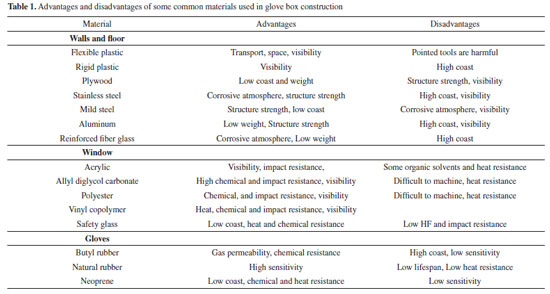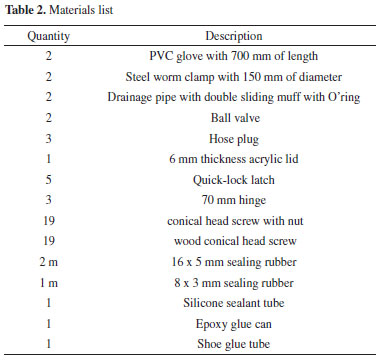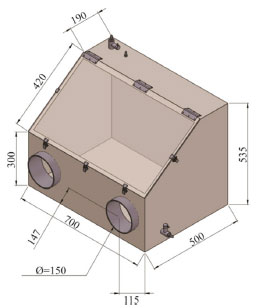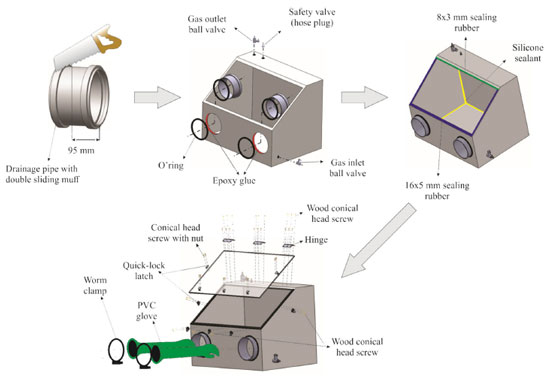Nota Técnica
| An accessible glove box project for procedures that require inert conditions |
|
Pedro Henrique do Nascimento Pereira; Jean Carlo Batista de Andrade; Pedro Ivo da Silva Maia; Geoffroy Roger Pointer Malpass*
Universidade Federal do Triângulo Mineiro, 38064-200 Uberaba - MG, Brasil Recebido em 23/06/2022 *e-mail: geoffroy.malpassuftm@uftm.edu.br An inert atmosphere is, in some cases, important for the performing of experiments where substances are toxic and/or sensitive to oxygen. However, the high cost and accessibility of an equipment to work under these conditions, results in the fact that most laboratories do not have this kind of equipment. In this paper, we present a simple and efficient project to build a cheap glove box for processes that require an inert atmosphere. The proposed glove box is made using medium density fiberboard (MDF), an acrylic lid, hinges, air valves, PVC gloves and other materials that can be found easily in local stores or on the internet. Tests to verify the quality of the nitrogen atmosphere were performed using the lighter test and niobium pentachloride (NbCl5), which is a moisture/oxygen sensitive material. The results demonstrated that the equipment is able to maintain an inert atmosphere for several hours, does not permit lighter to function and maintains the NbCl5 stable. INTRODUCTION A number of research areas, such as found in chemistry and biology, need to be conducted in appropriate local due to two main reasons: The first is to protect the researcher from toxic materials and the second is when the materials to be manipulated are moisture or oxygen sensitive.1,2 A Glove box is a simple apparatus that can solve these problems by coupling a pair of gloves in a sealed compartment which can be filled with an inert gas under at pressures that are slightly higher, lower or equal to atmospheric pressure. Many models of glove boxes are reported in the literature which can be cubic, trapezoid, cylindrical or in a bag-type format. The outer structure of such systems can be made from common materials, such as flexible and rigid plastics, plywood and metals. The transparent parts can be made using polymers or safety glass and gloves from different types of rubbers, each advantages and disadvantages, depending of the application, for example, a glove box made using a polyvinyl chloride bag is very easy to be transported and doesn't take up much space when it isn't in use, but it can be easily damaged by pointed tools.1 In the Table 1 a summary of advantages and disadvantages of some materials usually used to build this apparatus are reported.

A glove box is not that common in laboratories due its high market cost, which can make some kinds of study unviable as a result. The aim of this technical note is to propose a simple and accessible project for a glove box in order to make working under an inert atmosphere more feasible. The project uses materials that can be easily sourced locally or on the internet.
MATERIALS AND METHODS Glove box construction All materials presented in Table 2 were acquired locally. The wooden box was produced by a local joiner, in accordance with the dimensions given in Figure 1, using white MDF (medium density fiberboard) of 15 mm of thickness.

 Figure 1. Glove box dimensions (in millimeters). Internal volume: 135 liters
With the wooden box produced, all the components were mounted following the instructions given in Figure 2. First the drainage pipes with double sliding muff were cut at 95 mm width. Following this, using epoxy glue, these pieces were glued to the box using an inside/outside O-ring to reinforce the sealing. Holes (diameter 8 mm) were drilled in the right side and top side of the box to screw the inlet and outlet gas ball valves (screwed with hose plugs) and the safety valve (hose plug alone). Silicone sealant was applied at all internal junctions including valves nuts taking care not to clog them. To seal the acrylic lid, an 8x3 mm rubber strip was glued with shoe glue on the front top side of the box while 16x5 mm rubber was glued on the left, right and bottom side. After all glues and silicone sealant had dried, the acrylic lid was fixed on the box using three hinges. Five quick-lock latches were fixed using screws on the left, right and bottom side of the box to lock the acrylic lid so that a small pressure on the rubber is exerted when sealing the box.
Finally, PVC gloves were passed through the glued drainage pipes, and clamped with steel worm clamps. A parafilm was placed over the safety valve as a security seal, which in case of an internal increase pressure the seal will break. Optionally, a power plug and light can be installed in the box in order to connect small pieces of equipment, such as scales. In this case, there should be care taken to seal the wire entrance point. Preparing and testing the inert atmosphere To test if the glove box maintains an inert internal atmosphere, a lighter was placed within the box and the acrylic lid closed and locked. Before creating the inert atmosphere in the glove box, it was first checked that the parafilm on the safety valve was intact and that the outlet valve was open and then N2 gas was injected into the glove box through the inlet valve for a time that was dependent on the gas flow-rate, which can be calculated using the Equation 1. As an option, a vacuum pump can be connected to the outlet valve to help remove the atmospheric gas initially present in the glove box.

After the gas flow was completed, the inlet valve was closed first, followed by the outlet valve. At this point the using the lighter was attempted inside the inert atmosphere in the glove box. This was repeated several times at 0, 1, 2 and 3 hours the gas injection. A second test was conducted using a sample of niobium pentachloride (NbCl5), a yellow solid that is very sensible to oxygen and moisture, reacting to form niobium pentoxide (Nb2O5), a white solid. As a standard, a sample of NbCl5 was left in a traditional fume cupboard and exposed to the atmosphere, and the color change was monitored. The same procedure was conducted in the glove box under the N2 atmosphere. At the end, both samples were compared as regarding their color alterations.
RESULTS AND DISCUSSION After construction, the total glove box cost was R$ 916.84 or US$ 180.13 (considering an exchange rate of US$ 1.00 ≈ R$ 5.09 on 23rd August, 2022 - detailed costs available in supplementary material). The value is well below that of some commercially available equipment with a smaller size and made totally with acrylic (US$ 1408.85).3 This difference can be attributed, in part, to the material used in construction of the sides and base, as it is well known wood is cheaper than acrylic. Results of inert atmosphere tests demonstrated that in all assays the lighter didn't light up at any of the times tested, indicating that the sealing techniques were sufficient to maintain the atmosphere inert for several hours. With the NbCl5 test, the time to color change in direct contact with air was 20 seconds. For the sample in the glove box with the N2 atmosphere, the color remained unaltered for at least 4 hours, which also indicates the success of sealing method used. In this project, if necessary, many modifications can be performed, for example, in an application where the touch was not sensitive enough, the PVC gloves can be replaced by a thinner material (See supplementary material for more details). A system for internal cooling also can be adapted as described by Sanz,4 where two valves are attached to the side of the glove box, one for input and another for output of cooling fluid, which passes through an internal cooling coil. Other accessories, such as a pressure gauge or oxygen sensors also can be attached to the glove box but can make the project more expensive.
CONCLUSIONS A glove box was produced in this technical note, using materials which can easily be found on the market. A final cost that was ~12% that of a simple commercial product was obtained. Results of inert tests indicated that the N2 atmosphere can be maintained for several hours with the sealant techniques used. This equipment can provide some laboratories with an important tool for studies that require an inert atmosphere at an accessible cost.
SUPPLEMENTARY MATERIAL Some glove box photos described in this work can be accessed in the supplementary material in PDF format available free at http://quimicanova.sbq.org.br
ACKNOWLEDGMENTS The authors thank the Conselho Nacional de Desenvolvimento Científico e Tecnológico - CNPq (Processes: 140219/2020-0, 140220/2020-8 and 313447/2021-7) and the Fundação de Apoio à Pesquisa do Estado de Minas Gerais - FAPEMIG (Process: PPM-000147-17).
REFERENCES 1. Barton, C. J.; A Review of Glove Box Construction and Experimentation; Oak Ridge National Laboratory: Tennessee, 1961. 2. Dickman, M. D.; Chappelka, A. R.; Aff, C.; Gerhard, J.; Orcutt, R. P.; J. Clin. Microbiol. 1979, 9, 294. [Crossref] 4. Sanz, M.; J. Chem. Educ. 2010, 87, 854. [Crossref] |
On-line version ISSN 1678-7064 Printed version ISSN 0100-4042
Qu�mica Nova
Publica��es da Sociedade Brasileira de Qu�mica
Caixa Postal: 26037
05513-970 S�o Paulo - SP
Tel/Fax: +55.11.3032.2299/+55.11.3814.3602
Free access






